SEASONS

ELDERS WOOL, ONE YEAR ON PG 29
BUDDING AGRONOMISTS JOIN RENOWNED ELDERS GRADUATE PROGRAM PG 4 UNLOCK THE POWER OF YOUR HERBICIDE WITH HASTEN






ELDERS WOOL, ONE YEAR ON PG 29
BUDDING AGRONOMISTS JOIN RENOWNED ELDERS GRADUATE PROGRAM PG 4 UNLOCK THE POWER OF YOUR HERBICIDE WITH HASTEN




Elders’ Graduate Agronomy Program is renowned for producing some of Australia’s best agronomists.
A two-year, entry level program, participants are exposed to both horticulture and broadacre areas to expand knowledge of each. In addition, they gain a broad understanding of Elders and the agricultural industry.
Elders has welcomed 10 new graduate agronomists this year, who came together in Adelaide recently for a threeday induction program.
The group participated in a host of different activities to equip them in providing agronomic advice to growers right across Australia.
Graduate agronomist Grace McDonald, who commenced the program last year, said the graduate program is a valuable experience and a perfect way to become acquainted with the intricacies of agronomy and the industry as a whole.
“The last 12 months have been nothing short of exceptional,” Grace said.
“I’ve moved around the state, lived in towns I never would have passed through otherwise, and met so many new people.
"More importantly, I’ve been exposed to so many different cropping systems, scenarios, and landscapes.”
Leading this year’s intake, Early Careers Advisor Ella Anderson said the program has been successfully running for nine years, with more than 10 per cent of Elders' agronomy workforce today coming through the program.
“The Elders Early Careers Program offers a range of different learning experiences and the opportunity to learn from some of the industry’s best,”
“It is truly rewarding to watch each cohort of graduates make their way through the program, with an eagerness to learn and grow outside their comfort zones.”
Elders is a leading organisation for aspiring agronomists, providing exceptional opportunities to grow and succeed. A cutting-edge research and development program sets Elders apart as an industry leader, and with a network of trial sites across Australia, there is plenty of opportunity to be involved with projects at the forefront of the industry.
In addition to fostering a new generation of agronomists, Elders is also preparing to welcome a new group of livestock trainees. The Elders Livestock Career Development Program furthers participants’ knowledge about livestock sales and marketing, and enables them to gain exposure to livestock production and different farming systems.
Both first and second year trainees will meet in Tamworth next month. First year trainees will participate in their induction to the program, meet key livestock leaders within Elders as well as join the second year trainees to undergo critical training for safe livestock handling practices. In preparation for transitioning off the program, specially designed skills workshops will be facilitated for the second year trainees to equip them for success in their new permanent roles beyond the program. Ella said, “both the Graduate Agronomy Program and Livestock Trainee Program are great career pathways that set you up for success and launch your career in Australia’s most trusted agribusiness.”
Applications open soon for the 2026 intake of the Early Careers Program, for both budding agronomists and livestock trainees.

















Open a Rural Products Prepayment account and prepay into it and go into the draw to win a 2025 Grand Final getaway. Plus you’ll receive 5% p.a. reward on the unused amount of the Prepayment calculated daily, paid monthly.

HASTEN excels in breaking through the waxy plant cuticle, ensuring herbicides penetrate more effectively. It boosts adhesion and spread, enhancing compatibility and ensuring thorough coverage.

Australia’s top agri-chemical companies recommend their product is mixed with HASTEN Spray Adjuvant to deliver optimal effectiveness of their product on farm.

Pests may be small, but they can cause major damage to trees, fruit, exports, and income. Take control with VERTENTO® insecticide.
• Highly effective against key pests
• A new mode-of-action helps with resistance management
• Excellent residual control, means you spray less often
• Low 5 mL per 100 L water use rate, simplifies mixing and storage
Use VERTENTO ® insecticide to control the little things, and the big things will take care of themselves. For further information talk to your local Syngenta representative or visit Syngenta.com.au/vertento ...and the big things will take care of themselves.


In the ever-evolving world of crop protection, VERTENTO® insecticide emerges as a groundbreaking solution for tree crop growers. This innovative product, powered by PLINAZOLIN® technology, offers a unique mode of action that promises to revolutionise pest management in almonds, avocados, citrus, macadamias, mangoes and papayas.
VERTENTO® is classified as a Group 30 insecticide, making it the first of its kind registered for use in tree crops in Australia. This new mode of action is crucial for managing insecticide resistance, a growing concern in modern agriculture. The active ingredient, isocycloseram, works by targeting the insect's nervous system at a completely new site, ensuring effectiveness against pests that may have developed resistance to other chemistries.
With 400 g/L of isocycloseram, VERTENTO® insecticide boasts a remarkably low use rate of just 5 mL/100 L. This concentrated formulation not only reduces the amount of product needed but also minimises environmental impact with less packs to transport, recycle and takes up less room in the chemical shed.
Despite its low use rate, VERTENTO® insecticide delivers robust efficacy against key pests such as spotting bugs and macadamia seed weevil.
VERTENTO® insecticide acts through both contact and ingestion, stopping pest feeding within hours of application. While it effectively paralyses insect pests immediately, it may take a couple of days for them to fall from the trees.
The VERTENTO® insecticide formulation has been specifically designed to withstand the harsh Australian climate.
Its excellent sunlight stability and rainfast properties ensure consistent protection for your crop, even in challenging weather conditions.
With registrations in almonds, citrus, avocados, mangoes, macadamias and papayas, across a range of key pests, VERTENTO® insecticide has versatility; making it a valuable tool for growers managing diverse orchards. With a wide window of application, it also makes it easy for growers to include in their insect management program.
Like any crop protection application, to maximise the effectiveness of VERTENTO® insecticide, growers must prioritise thorough coverage and accurate dosing. The product sits on the surface of the plant, making it essential to achieve complete and even distribution across the crop canopy. Always use a non-ionic adjuvant such as AGRAL® spray adjuvant with every application to en
It is also important to adjust water volumes according to crop growth stage to ensure thorough coverage, and be aware that new growth emerging after application may not be protected. Timing is crucial – monitor your orchard regularly and apply VERTENTO® insecticide only when local economic thresholds are reached and adhere to the label instructions, including the maximum number of applications per season and the minimum interval between sprays.
While VERTENTO® insecticide is a powerful tool, it should be included as part of a comprehensive integrated pest management strategy. VERTENTO® insecticide may disrupt some beneficial arthropods. Care should be taken to minimise spray drift to reduce harmful effects on beneficial arthropods in non-crop areas. Using VERTENTO® insecticide only when pests reach
threshold and carefully timing beneficial releases will ensure pests are controlled and beneficials are not adversely impacted.
Orchard hygiene is also important. For instance, to assist macadamia seed weevil control or Carpophilus beetle in almonds, remove and destroy fallen nuts within two weeks of spraying to prevent the pest lifecycle from completing.
VERTENTO® insecticide represents a significant advancement in tree crop protection. Its novel mode of action, low use rate, and robust efficacy make it a valuable tool for growers seeking to optimise their pest management strategies. By incorporating VERTENTO® insecticide into your program and following best application practices, you can enhance the protection of your orchard, potentially improve crop yields and quality, and ultimately increase the profitability of your tree crop operation. With its impressive performance and unique chemistry, VERTENTO® insecticide has the potential to become an indispensable tool in your efforts to grow healthy, productive tree crops for years to come.
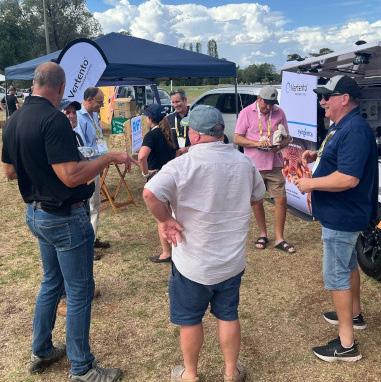
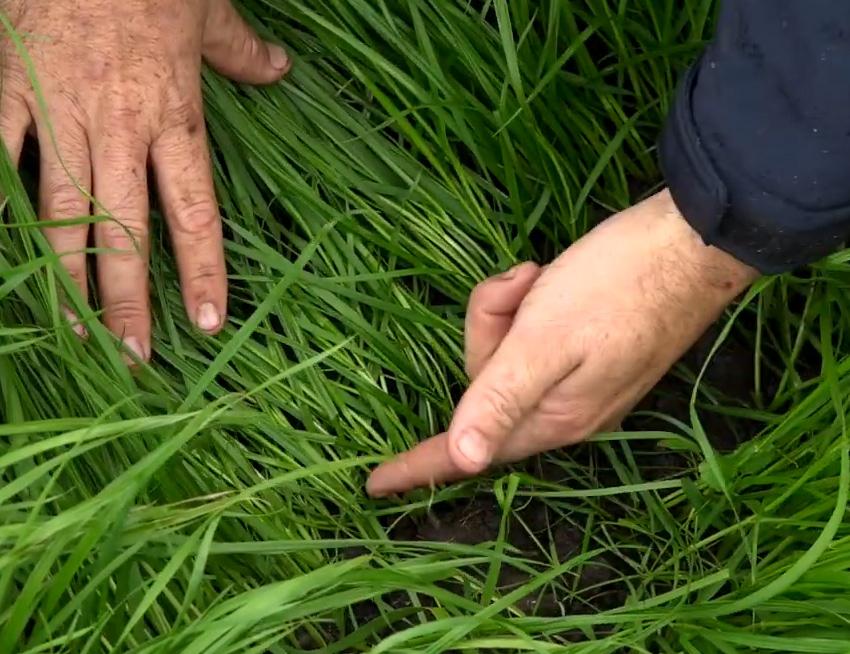

Winter pasture feed gap filler ProGibb Smartgrass (SG) began life as a plant growth regulator in Australian table grapes, but it was the accidental discovery of its success in pasture management some 20 years ago that opened a global market for agricultural solutions supplier Sumitomo Chemical.
Today, ProGibb SG is a firm fixture for dairy farmers throughout Australia’s temperate pasture zones who rely on it to improve winter pastures when growth naturally slows during cool weather.
Sumitomo Chemical Australia’s regional manager northern New South Wales and New Zealand, Phil Glover said ProGibb SG contained the natural plant growth regulator gibberellic acid that naturally occurs in pastures such as perennial rye grass, phalaris, cocksfoot, lucerne and annual rye grass but levels are much reduced in the cold winter months. Boosting gibberellic acid levels in the plants with an application of ProGibb SG therefore significantly increases pasture growth.
“Pasture depletion during winter and cold soil temperatures affect farm income as a consequence of increased costs caused by supplementary feeding,” Phil said.
“However, ProGibb SG can significantly reduce the reliance on and cost of supplementary feeding. Comparatively, it’s an affordable and easy to use option.”
He urged farmers to order supplies now ahead of using ProGibb SG from June-August to provide quality feed for milk production.
“ProGibb SG contains a high concentration of gibberellic acid formulated as a low dose water soluble granular formulation for easy application,” Phil said.
“It boosts plant growth in winter-dormant grasses by stimulating cell expansion, resulting in leaf and stem elongation and rapid foliage growth.
“Moisture and fertiliser are critical to its performance and trials show that the consistent use of ProGibb SG in
conjunction with a nitrogen-based fertiliser such as Easy N results in complementary and additive growth responses. Another benefit is that it’s compatible with insecticides and most herbicides so farmers can do two or three jobs at a time.
“The time to apply ProGibb SG is within a day or two after grazing. A single low application, well below the cost of a little bail of hay ($20/ha) can generate an improvement in dry matter production up to 60 per cent in about three weeks. However, significant results can be achieved if it’s used via multiple applications. We know of some farmers using it consistently two or three times a season on the same paddock, depending on how cold it is.
“Farmers wouldn’t keep using it if it wasn’t any good.
“Between 1500kg and 2500kg of good quality dry matter per hectare is the ideal pasture quantity to ensure optimum animal production. The result is a significant increase in milk production and the same quality of milk and there’s also an improvement in cattle health.”
Sumitomo Chemical Australia recommended using 20g/ha for most pastures and 10g/ha for phalaris which was particularly responsive.
Phil said grazing rotation could also be reduced from 30 days to 18 days with ProGibb SG in the mix, maximising productivity time.
ProGibb SG had been used successfully in Australian table grape production and other horticultural crops such as citrus and stone fruits for about 40 years until it was applied to pasture management in a research and development phase two decades ago. As well as dairies, it is now widely used in high-density grazing such as sheep lambing and beef fattening paddocks.
“Based on its positive outcomes in Australia, ProGibb SG is now used in New Zealand, England and parts of Europe,” Phil said.



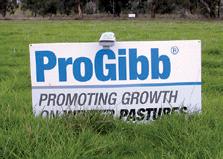

Winter and spring are vital months for balancing pasture growth and providing quality feed for meat and milk production.
Sumitomo Chemical Australia Pty Ltd has trialled ProGibb SG in commercial situations since 2004 demonstrating increases in grass pasture production can be achieved during winter months.
ProGibb SG applied to pasture during winters coolest months will stimulate pasture growth and increases dry matter per hectare with no loss of feed quality (megajoules ME per kilogram of dry matter).
Scan here to see more information about ProGibb SG
• ProGibb SG increases Dry Matter per ha.
• ProGibb SG increases carrying capacity.
• ProGibb SG reduces supplementary feeding.
• ProGibb SG increases profitability from pasture.
• No withholding period and no residues in either meat or milk.
• ProGibb SG can be utilised in all pasture based systems including fat lamb, beef, dairy, equine, deer and goat operations.


Utrisha® N can convert atmospheric nitrogen to a plant-available form inside the leaf.
This ground-breaking foliar-applied technology ensures nitrogen is supplied to the crop, even when other sources aren’t available, giving growers more flexibility with their nitrogen management strategies.
Utrisha ® N is a biological solution that works with a variety of crops to supply supplementary nitrogen throughout the growing season for improved plant health and increased yield potential
Embrace a balanced future

Field trials across three key Australian grain growing regions have delivered the most comprehensive trial data to date showing the “significant influence” of nutrient efficiency bio-stimulant Utrisha N® on crop yield.
The three large-scale wheat trials in Corrigan (WA), Esperance (WA) and Cummins (SA) were designed and analysed by Analytics for the Australian Grains Industry (AAGI), a collaboration between Curtin University, the University of Adelaide, the University of Queensland and Grains Research & Development Corporation (GRDC).
Each trial was conducted in approximately six-hectare plots, where treatment of Utrisha N was accompanied with three-to-four levels of nitrogen (from zero to 150 per cent normal treatment) and compared to variable nitrogen treatments alone. Advanced spatial analysis using harvest pixels allowed researchers to isolate treatment impacts from natural soil variation, providing a robust assessment rarely seen in commercial field trials.
The AAGI reports found across all three trials that Utrisha N had a statistically significant impact on crop yield.
“The analysis revealed that level of nitrogen application, the use of Utrisha N and the interaction of the two factors all significantly influence crop yield,” the Corrigin trial report said.
Similar findings were reported following the trials in Esperance and Cummins.
Corteva Agriscience Customer Technology Specialist Justin Mercy said the trials were setting a new standard in research in biologicals.
“We were able to get a level of granularity in these trials that is quite rare, especially in the relatively new field of biologicals,” Justin said.
“Traditional trials might rely on five or six data points. In contrast, these trials analysed between 1604 and 2836 data points, allowing us to separate the effects of varying soil types across the sites. The outcome is a much clearer picture of how Utrisha N performs in the real world.”
Corteva Agriscience Marketing Manager Dan Cornally said the results demonstrated how this innovative, foliar-applied nitrogen-fixing product can contribute to improved nutrient efficiency and productivity in both lowand high-input systems.
“At both the Corrigin and Esperance sites, the addition of Utrisha N resulted in higher median or predicted yield across several nitrogen rates,” Dan said.
Importantly for growers, Dan said it pointed to a positive return on investment. “These three trials were run in a drier than normal season and
we saw positive yield results across the nitrogen dose curve in all three.”
These results give us confidence that Utrisha N can be another tool in the shed, especially where late nitrogen application is inefficient or not possible due to weather.”
Justin said the independent design and analysis behind the trials were key to validating Utrisha N’s performance.
“Using a clustered linear mixed model approach allows us to account for spatial variation, which is the “gold standard” of farmscale research,” he said.
“We deliberately asked for a more rigorous scientific approach – not just paddock averages but a pixellevel understanding of what’s really happening across soil zones.
“That meant capturing and analysing harvest data at a much higher resolution. Paired data points on the same soil type were compared rather than averaging all the data points and assuming the paddocks soil was uniform across the paddock.”

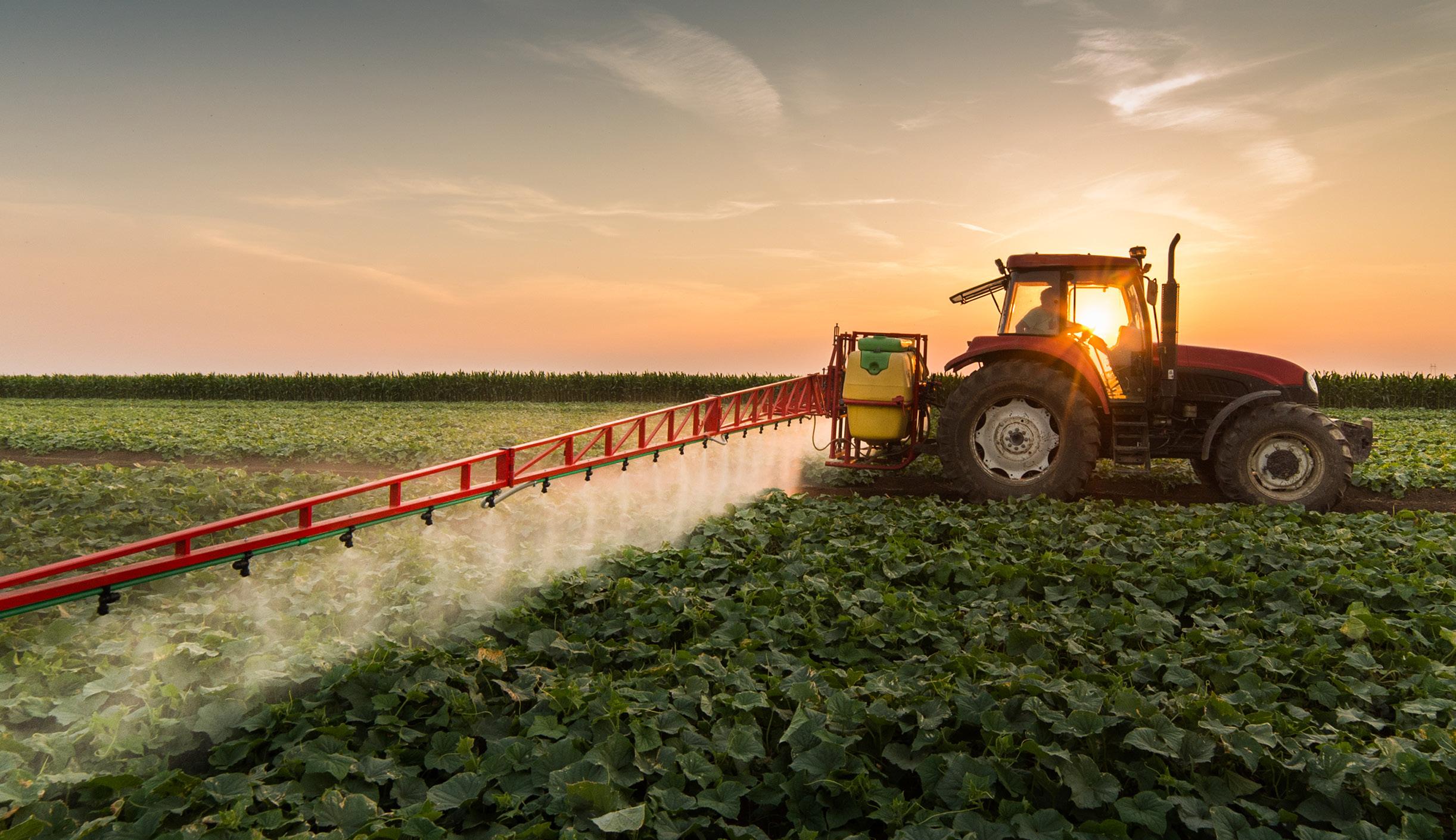
According to the Cambridge dictionary, the meaning of the word ‘hasten’ is ‘to make something happen sooner, or more quickly’.
That sounds like what most growers expect from an esterified seed oil spray adjuvant – for it to speed up and improve the herbicide partner it is mixed with, killing weeds quickly and effectively.
It also describes exactly what Kwickin Spray Adjuvant and Plantocrop Spray Adjuvant do.
Better known to growers on the east coast and South Australia, Kwickin Spray Adjuvant is a highly penetrating spray adjuvant suitable for use with certain post-emergent herbicides, insecticides, fungicides, defoliants and desiccants.
Plantocrop Spray Adjuvant is the familiar equivalent of Kwickin in Western Australia, designed to enhance the penetrating properties of postemergent herbicides, fungicides and insecticides and is particularly suitable for cold water applications.
Both products are available from Elders and are DKSH’s solutions for growers who are looking for a comparable, high-performance esterified seed oil adjuvant that does it all.
Kwickin and Plantocrop Spray adjuvants:
> are biodegradable, environmentally responsible and sustainable vegetable-based spray adjuvants
> have a high level of efficacy and superior crop safety
> increase wetting, spreading and penetration through waxy cuticles -resulting in improved uptake of the pesticide partner/s it is mixed with
> have been used and proven to be compatible with thousands of spray mixtures over two decades
> are suitable to be used with all products which state on their label that they are to be mixed with an esterified crop oil
> are manufactured from methyl and ethyl esters of fatty acids derived from Australian sources of food grade canola oil
> work particularly well when mixed with Group 14 herbicides
> are extensively supported and recommended by herbicide manufacturers
> are a blend of esterified vegetable oil and non-ionic surfactants that is suitable for use as a spray adjuvant for herbicides, insecticides, fungicides, defoliants and desiccants
> reduce pesticide loss by producing less driftable droplets.
> reduce evaporation of spray droplets to deliver more pesticide on the target for improved results
> are available in 20L, 110L and 1000L containers
Plantocrop is known to be suited for the sometimes-challenging spray conditions in Western Australia, particularly when mixing in sub-10 degree temperatures. It has excellent emulsion stability in cold water. It also has a high level of UV-stability allowing for greater availability of the active ingredient partner on the target crop.

AXIAL® Xtra delivers wheat and barley growers improved activity on grass weeds such as wild oats and phalaris, all without impacting crop safety.
Designed to maximise application properties, compatibility and performance, AXIAL® Xtra delivers exceptional results with no compromise on formulation quality.
For further information on the Xtra benefits, talk to your local Syngenta representative or visit syngenta.com.au/axialxtra




Pinoxaden remains a valuable tool for the management of wild oats, phalaris and annual ryegrass in wheat and barley crops, with AXIAL® Xtra herbicide being the leading choice in terms of efficacy and ease of use.
AXIAL® Xtra herbicide has been proven to perform better in more marginal conditions or where target site resistance exists to other Group 1(A) herbicides, thanks to the Syngenta product’s superior uptake within target weeds.
AXIAL® Xtra herbicide is also the dependable choice in many real-world conditions, where problems can easily arise, saving users time and money in the long run.
Here’s six reasons to consider choosing AXIAL® Xtra herbicide over a generic pinoxaden:
1. AXIAL® Xtra is formulated for all water types. Laboratory tests have proven that AXIAL® Xtra mixes well in hard water, as well as cold water. This means it will stay suspended in a spray tank, without causing nozzle blockages.
2. A low-foaming formulation, AXIAL® Xtra is not prone to tank mixing difficulty, saving time when mixing compatible products, and fewer delays to spraying.

3. Extensive experience with AXIAL® Xtra has shown that it has stable shelf life. Unlike some other formulations, AXIAL® Xtra doesn’t crystalise during storage or settle out. So, if your spray program changes throughout the season, or you’re holding partially used drums from one season to the next, users will have fewer worries.
4. AXIAL® Xtra has an optimised, built in adjuvant. Extensive Syngenta trials have found superior efficacy thanks to the optimisation of the adjuvant loading. This results in efficient dispersion onto target weed leaves and better uptake, for a faster brownout.
5. AXIAL® Xtra includes a proven safener developed by Syngenta, which provides greater peace of mind when it comes to crop safety in wheat and barley.
6. Syngenta was the first to bring pinoxaden to market, as AXIAL®, now sold in countries around the world. Being the first, Syngenta has an unrivalled understanding of this active ingredient and has invested more time than anyone ensuring that users can manage grass weeds with maximum efficacy.
AXIAL® Xtra is also an excellent alternative to fop herbicides such as fenoxaprop. Being structurally different to FOPs, AXIAL® Xtra is able to overcome FOP target site and metabolism resistance.





If you’ve ever wondered what happens when deep geological history meets modern agricultural science, look no further than Omnia Specialities Australia. Based in Morwell, Victoria, Omnia is quietly leading a revolution in how growers improve their soils, nutrient efficiency, and ultimately, their yields — all thanks to humic substances extracted from 50-millionyear-old brown coal.
It’s not just any coal either. The Leonardite found in the Gippsland Basin — sometimes fondly called “50-millionyear-old compost” — is among the richest sources of humic substances on Earth. As Omnia managing director James Freemantle explains, this Australian Leonardite is geologically younger than the US equivalent and having been formed in fresh water is lower in mineral content, and that makes all the difference: it’s more highly oxidised, richer in humic concentration, and, critically, uniquely suited to modern crop production systems.
The science behind it is fascinating. Formed during the Late Eocene to Middle Miocene periods, these coals originated in vast, waterlogged swamps where dense layers of plant and tree matter decomposed under aerobic conditions. Over millions of years, microbial action, pressure, and time transformed this biomass into humate-rich peat, and eventually into brown coal. This material contains extraordinarily high levels of humic and fulvic acids, known to improve nutrient uptake, soil structure, and microbial activity in agricultural systems.
At the Morwell processing plant, Omnia’s operations team — led by Francois Stander — extracts these compounds using a highly controlled alkaline extraction process. What emerges is a suite of products, including high-concentration liquid potassium humate.
Omnia’s process doesn’t stop at production. Every batch undergoes rigorous quality control. “Once a batch is made, it’s tested for humic/potassium content, density, and pH.
If it doesn’t meet spec, it doesn’t go,” Stander explains. “This is not just a price-point market — it’s a quality and performance game”.
Independent testing has proven that Omnia's 26% humate product is among the highest concentrations available globally — a result that underscores its agronomic value in real-world farming systems.
What sets Omnia further apart is its commitment to transparency and scientific rigour. The company partners with globally accredited laboratories — including one in Spain — to provide external certificates of analysis for export clients, particularly those in North and South America, Asia, and the Middle East. These markets are increasingly demanding not just efficacy, but also data-backed consistency.
To keep up with surging demand, Omnia is investing in technology. A new decanting centrifuge — now being commissioned — will reduce the humate separation process from three days to just four hours. This not only increases throughput but improves product consistency by removing more insoluble content.
In essence, Omnia isn’t just selling a soil amendment; it's delivering a precision-engineered input with measurable agronomic value. Their products act as biological and chemical enhancers — not replacements — to traditional fertilisers, improving return on investment and sustainability for growers worldwide.
It’s a global success story rooted in a unique Australian resource. Or, as Freemantle puts it: “We’ve taken a geological gift and turned it into something growers around the world can use to grow more from less”.
In a world demanding ever-higher agricultural productivity with lower environmental impact, Omnia is proving that sometimes, the best innovations begin 50 million years ago.
• Promote soil structure
• Boost crop nutrition
• Support beneficial microbes
• Increase plant vitality
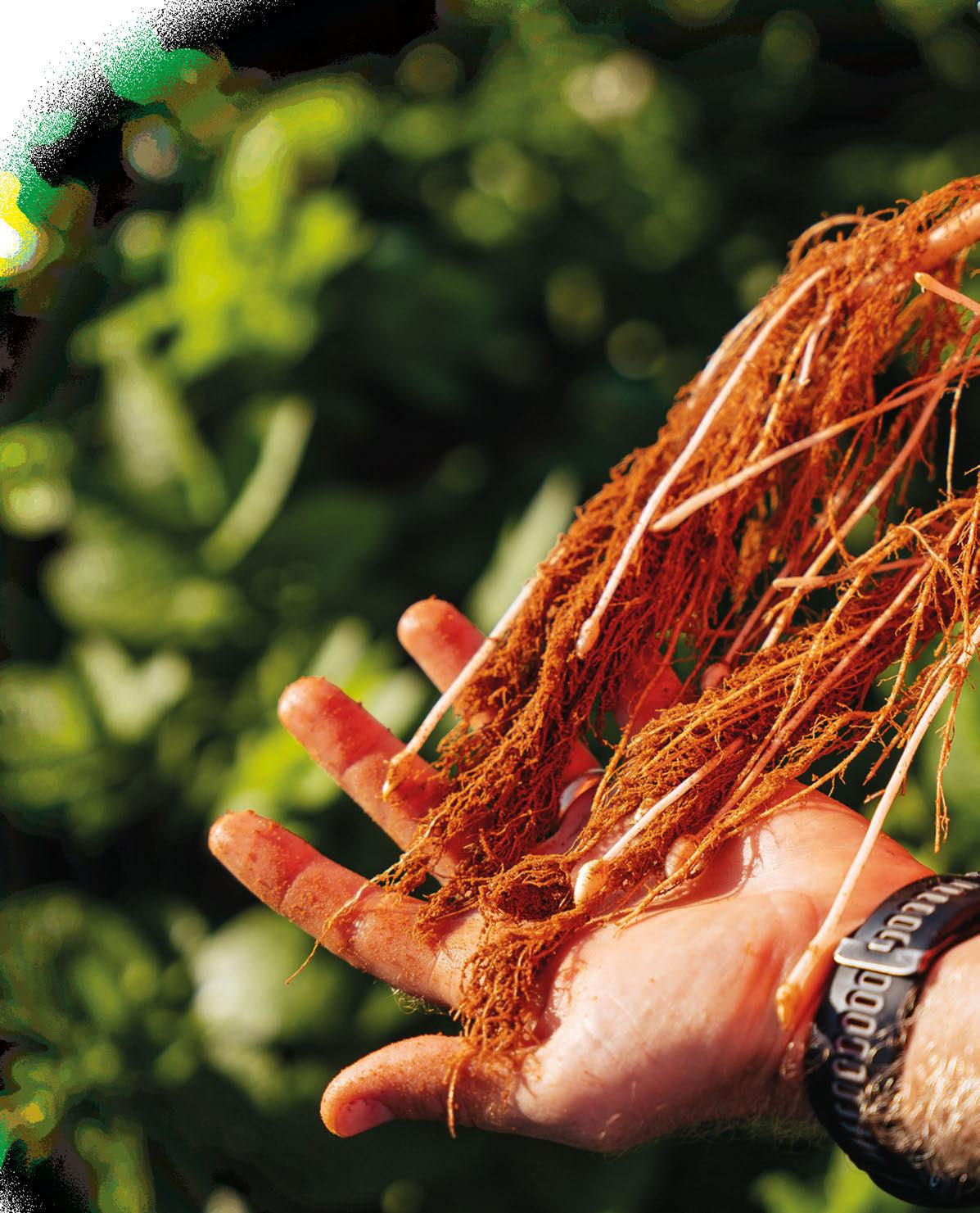




High quality, leading forage seed varieties for the grazing animal, hay & silage
Mainstar forage rape: Palatable & versatile
Sow for early maturing feed (10-12 weeks), with a high leaf to stem ratio, Aphid tolerance & superior animal preference.
Warrego GT6: Dormancy 6 lucerne for premium quality hay & grazing
Experience the benefits of improved persistence with Warrego GT6, the Australian bred, upgraded replacement to Stamina® GT6.
Ecotain® environmental plantain: Take your livestock to new heights
Sow for mineral rich, high protien, fast establishing feed with innovative environmental & animal health benefits.
Growing up on a farm in Mareeba coupled with 19 years’ experience as an agronomist, Gerry has a unique perspective on agricultural and seeding practices in far north Queensland when it comes to pasture seed selection, sowing and establishment.
And, as a seasoned Sales Agronomist with DLF Seeds, he is eager to share his top tips and mix recommendations to graziers, and rural retailers that assist in selecting varieties for/establishing a successful tropical or subtropical pasture, that will provide ample cow feed, hay or silage.
GERRY’S 101 GUIDE TO PASTURE GRASS SEED
When it comes to establishing the right pasture for tropical and subtropical climates, Gerry recommends the following steps:
> Prepare the seed beds properly by clearing the area of weeds and debris.
> Seek out advice from experts including your local Elders or DLF Seeds Sales Agronomist
> Conduct a soil test to understand the soil nutrition. This will aid us in knowing the best seed mix for your pastures and identify any nutrition deficiencies.
> Source high quality seeds for planting and plant with the best equipment at your disposal, preferably a seeder.
> Use a pre fertiliser to provide nutrients to pastures.
> Once established, don’t graze too early! To check if the pasture is ready for grazing, wrap your hands around the grass and trying to pull it out. If the grass releases, it is ready for grazing.
> If you can’t pull it out, you can do a crash graze to bring the pasture down to about 200mm (this encourages quick regeneration and tillering).
Once tropical and subtropical pastures are properly established, they usually last multiple years. To get the most out of a pasture, keeping good management practices such as staying on top of grazing to avoid pastures becoming rank, will ensure you’re weed burden in minimised and that your stock feed, yield, feed nutrition content, and profit is maximised.
Choosing the right seed varieties that complement your environment and stock finishing goals, also play a huge part in the success of your pasture.
In tropical and subtropical climates like North and Central Queensland, Gerry says the right seeds can persist through extreme weather conditions, including flooding.
“The main grasses I would recommend for a tropical region is Callide Rhodes, Gatton Panic, Katambora Rhodes, Jarra grass and Mekong Briz™ antha brachiaria. For legumes, V8™ stylo, Burgundy Bean and Cardillo cento™,” he says.

Gerry also underlines the importance of sourcing high quality seeds that are fit for the farm’s soil type, emphasising the importance of clearing the area of weeds and debris to create the best environment for seed growth and prevent pests.
AND HUMIDICOLA OUTCOMPETE WEEDS LIKE GIANT RATS TAIL GRASS DUE TO THEIR VIGOROUS AND HIGH COMPETITION GROWTH.
“Weed grasses like Giant Rats Tail can be prolific in these climates, but the right grass choice can reduce its effects. Mekong and Humidicola are the best grasses to help control Giant Rats Tail, they’re quick growers and can out compete it for sunlight, improving overall pasture quality.”
Gerry works with graziers, farmers and rural retailers across Queensland to create and provide the ideal mix of cultivars that suits their needs.
“I enjoy walking through their farm to understand their goals and system. This helps to determine the steps and preparation needed, to provide them with the best possible product that complements their soil type, environment and their farm goals,” Gerry explained.
“I’ll ask what soil type their farm is, which helps me choose the species of grass or legumes. I’ll also ask what’s going to be grazing there – whether it’s wieners, steers or breeders, because they all have different nutritional requirements from a cow feed perspective.
“With wieners and steers, you want to put weight on them quite quickly and get them ready for sale, while for breeders it’s about keeping them healthy for breeding.”
Looking ahead to spring sowings for tropical and coastal climates Gerry recommends a balanced mix of pasture grass and legume seed species to ensure robust pasture growth.
“If you are looking for high yields, and have 500mm or more annual rainfall, three to four kilograms per hectare of Mekong and two to three kilograms per hectare of Callide Rhodes, is worth considering,” he says.
“To add a nutritional and Nitrogen fixing legume component to this mix, consider adding two kilograms per hectare of legumes such as V8™ stylo and one kilogram per hectare of Burgundy Bean.”
The benefit of custom pasture seed mixes is that it can be tailored to an environment and farm goals.
“As with all custom mixes, this grass and legume mix would need to be adjusted slightly to meet the needs of each farm and the environmental conditions. Once this custom pasture seed mix of grass seed and legume seed has been tweaked to suit your operation, graziers may benefit from 10 or so kilos per hectare of a nutritious pasture, that is suitable for various grazing needs and environmental conditions.” Gerry concludes Ultimately, a tropical pasture mix of grasses and legumes is a great seed mix option for cattle feed, cattle grazing, hay and silage.
For more information on DLF Seeds varieties, visit dlfseeds.com.au or consult you local Elders or DLF Seeds Sales Agronomist
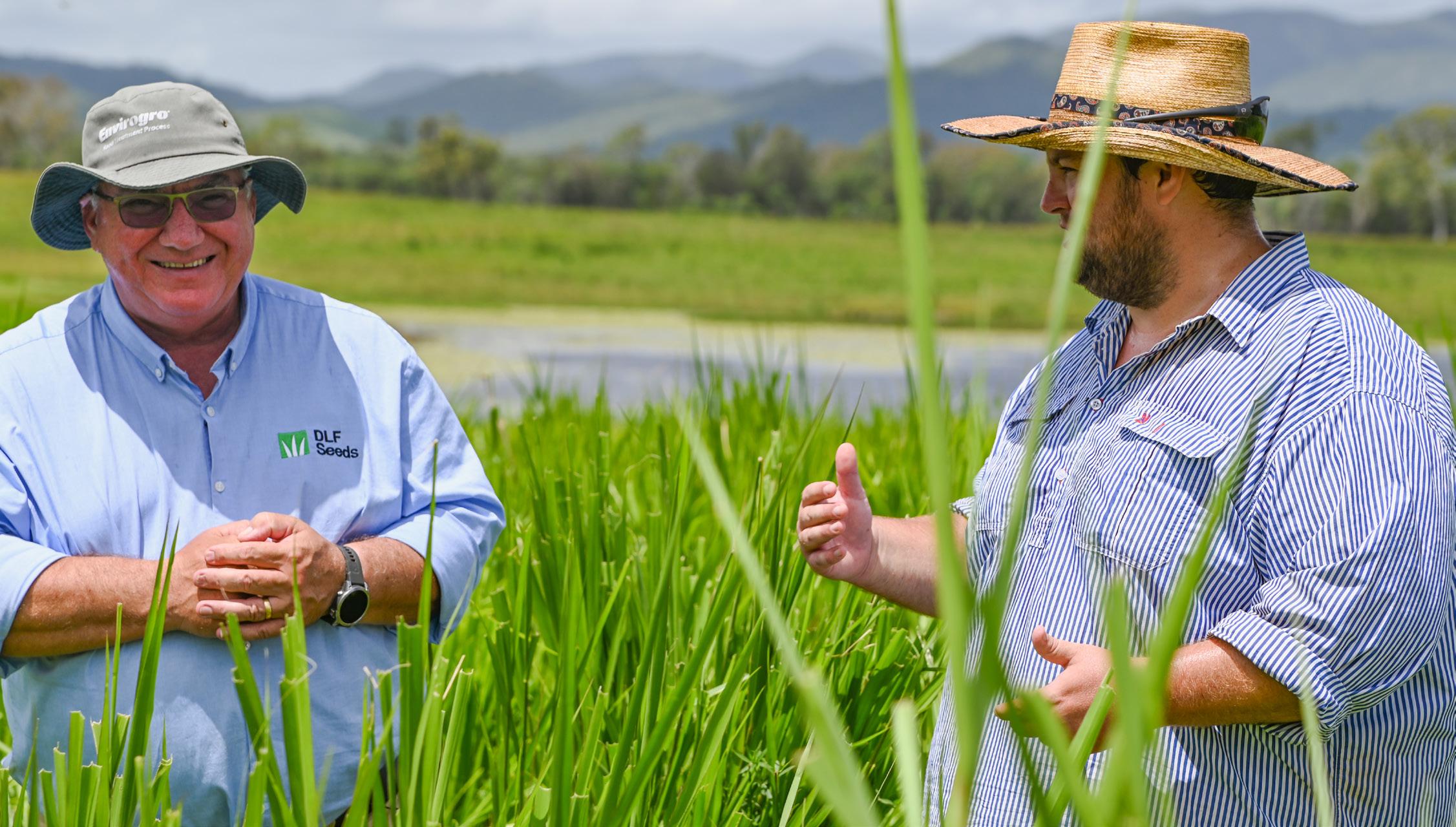


As a cattle producer, you might have heard of Leptospirosis, but are you fully aware of how it can affect both your livelihood and your health? In this article, we’re going to focus on the serious implications of this oftenunderestimated disease, examining both the economic consequences on cattle productivity as well as its impact on human health.
ECONOMIC
The presence of leptospirosis in a herd can severely disrupt the profitability of a farm. The disease notably affects the reproductive health of cattle, leading to an increased number of non-pregnant cows. A drop in pregnancy rates can significantly delay a farm's breeding program and genetic advancements.
AN EXAMPLE SCENARIO:
Let’s say you have a herd of 100 cows, if the pregnancy rate decreases from 90 per cent (pc) to 80 pc due to Leptospirosis, it results in 10 fewer calves.
What’s the financial impact? With each calf potentially earning $800, the loss totals $8,000 just in calf sales.
But it doesn’t end there. There are actually a wide range of broader economic consequences that can result in further losses of farm profitability including:
> reduced milk production;
> higher culling rates due to decreased fertility and health;
> longer calving intervals, affecting yearly production cycles; and
> additional costs from increased veterinary care and disrupted herd management.
Leptospirosis is more than just a livestock disease —it's a direct threat to those who work with cattle. This disease spreads through bacteria that are often transferred via infected urine and contaminated water or soil. Farmers and agricultural workers are particularly vulnerable, risking symptoms that range from mild (similar to the flu) to severe (potentially life-threatening). For some people, leptospirosis can lead to severe long-term effects on human health, which can be debilitating and lead to chronic conditions that can impact quality of life and ability to work.
Did you know? People working in abattoirs are also at risk of contracting leptospirosis due to frequent exposure to potentially infected animal blood and tissues.
The potential issues and losses, both from an animal and human perspective described above underscore the critical importance of disease prevention through vaccination and herd health strategies. Here are seven key steps for comprehensive control of leptospirosis and associated risks.
1. Vaccination: A robust vaccination plan is crucial. Use an appropriate vaccine like Websters 7-in-1 to protect against relevant strains.
2. Hygiene and Personal Care:
> avoid contact with urine.
> wear appropriate Personal Protective Equipment (PPE).
> wash and dry hands thoroughly
> avoid eating, drinking, smoking, or vaping in areas where there's a risk of contamination.
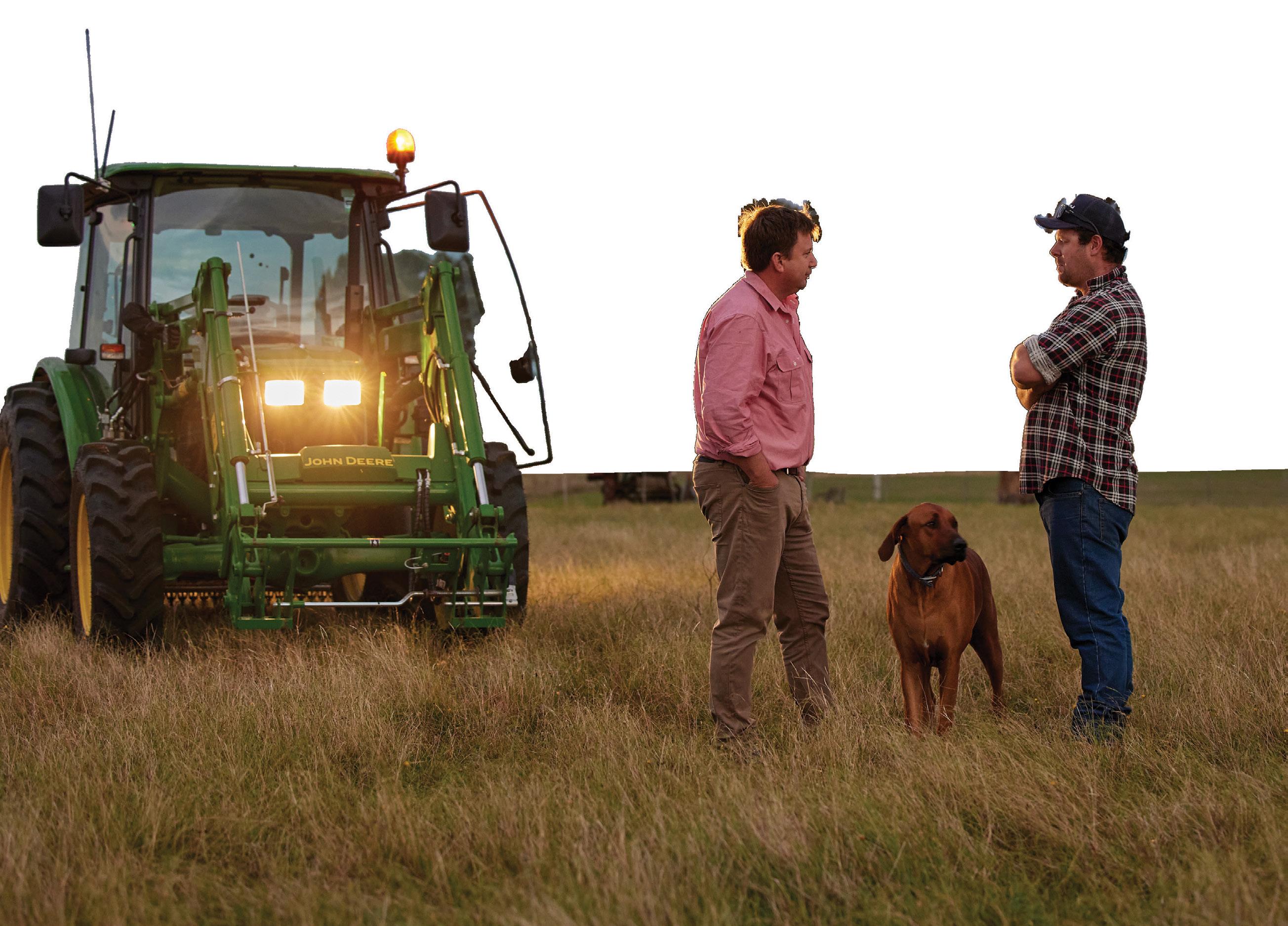
It has been just over a year since Elders commenced operations through its groundbreaking wool handling business.
Elders' investment of $25 million in this new venture marked the largest single investment in wool handling this century, demonstrating a long-term commitment to the industry. The two centralised wool handling facilities, based in Melbourne and Perth, have since revolutionised the wool supply chain.
The Melbourne centre uses electricpowered autonomous guided vehicles (AGVs) to move bales of wool, significantly reducing energy consumption and improving operational efficiency. The 22 AGVs, which are powered by on-roof solar panels, operate 24 hours a day.
National manager of Elders Wool operations Michael de Kleuver said the AGVs have provided significant operational and safety benefits since their installation.
“One of the things that the automation does well is reduce the cost of processing a bale of wool. We can use the height of our centre to our advantage, and reduce the labour needed for the business to function,” Michael said.
Over on the west coast, the Perth facility first processed wool in July 2023. Operations Manager Ryan Fletcher said although it has been a difficult year for WA wool producers, clients continue to have confidence in the Elders team, thanks in part to the new business.
“Though the wool quantity in the west has definitely dropped, Elders has been perceived positively and we continue to attract new clients,” Ryan said.
“Our district wool managers have been very present in the bush and are keen to look after growers across the state. Recently the price of wool has been on the upward, with a prediction of that this trend will continuously move up, so we are hoping it encourages the growers to hang in there.”
Michael explained the new consolidated approach through both centres has created efficiencies for growers.
“We bring wool to Perth from all over Western Australia, and wool goes to Melbourne from all over the east coast; South Australia, Queensland, New South Wales, Tasmania, and Victoria. What we are doing is very efficient and low cost, and those efficiencies will get even better over time,” Michael said.
“We are hoping that we can maintain our costs at a lower level for longer. The cost of labour on farm, the cost of shearing, the cost of everything is going up and the wool price is the same as it was a number of years ago, so anything that can save a dollar in the process, whether on farm or in the supply chain, is worthwhile.”
This approach to wool handling underscores Elders’ commitment to innovation and sustainability and also sets a strong foundation for the industry's future growth and resilience.
Elders client Sandy Heal owns and manages a Merino operation in Victoria’s Goulburn Valley region, and said the establishment of Elders Wool has given her a sense of confidence in the sector.
“We have spent a lot of money on our infrastructure in the last five years; covered yards, sheep fencing, basically everything associated with sheep,” she said.
“To see Elders making this kind of investment in the industry is a really good feeling and gives me a lot of confidence moving forward.”

Robust and flexible control when it matters most
• Powerful insecticide which works on target pests through ingestion and contact
• Translaminar movement to underside of leaves (single application, dual exposure)
• A new active ingredient within Group 30, with no known resistance

Scan QR code to speak to your local BASF representative to find out more

• A new benchmark for protection against sclerotinia and upper canopy blackleg
• Rapid uptake and strong, long-lasting residual activity
• Highly profitable protection for high-yielding canola crops
• Improved control of key diseases in wheat, barley and oats as well To





Our new pyrasulfotole, Nufarm Galaxy allows a flexible and customised mix-partner ratio, providing optimum control of challenging, early post-emergent broadleaf weeds.
Tank mix with ease. Broaden your weed spectrum with this highly compatible product.
Ultimate flexibility. Customise your pyrasulfotole requirements to suit individual situations.
Optimum control. Excellent efficacy on brassica weeds including Wild radish, Wild turnip, Indian hedge mustard.
To find out more, scan the QR code or speak to your reseller.
Nufarm Galaxy is delivering impressive results for cereal growers across Australia, with an innovative approach to Group 27 herbicide use.
As a unique, straight pyrasulfotole product, Galaxy combines one of the most robust broadleaf herbicides on the market with the ability to adjust rates and mix partners, like bromoxynil or MCPA LVE, throughout the growing season.
Nufarm Australia Commercial Technical Lead Mitch Allen has been involved in a large amount of field trial work for Galaxy and regularly receives commercial feedback in the paddock.
“Everyone has been very impressed with the flexibility and efficacy of Galaxy. Not just that, but it has the excellent level of crop safety we expect from a pyrasulfotole product,” Mitch said.
FLEXIBLE
Galaxy is a game changer in the post-emergent herbicide market, giving growers a choice of higher maximum use rates of both the active ingredient and mix partners. With little known resistance, this flexibility makes it good news for growers looking to manage a wide spectrum of hard-tocontrol broadleaf weeds, including wild radish, Indian hedge mustard, sow thistle, wireweed, and volunteer canola.

“In the efficacy space, we’ve done work with Galaxy in different mixes and at different rates - you choose your mix partner and your mix rate to suit your weed control situation. You aren’t locked into one mix and rate option only. You can also use a higher rate of bromoxynil compared to other pyrasulfotole products,” Mitch said.
“This is a product we are seeing used across the country because of its flexibility and therefore ability to be targeted for the situation. It has a strong reputation for its efficacy on radish as well as wireweed and sow thistle among others.”
With Galaxy, Nufarm brings a more flexible pyrasulfotole to a broader range of growers and use patterns. It’s an excellent choice for growers who have avoided pyrasulfotole in the past because of the limitations of pre-mixed formulations. Being a group 27 herbicide, Galaxy is great option to rotate away from commonly used group 2 or group 12 based herbicides. Nufarm has invested in R&D to ensure Galaxy is not only a more versatile product, but also one that’s efficacious and highly competitive in the market.
Galaxy must always be tank mixed with another herbicide like Bromicide 200, Bromicide MA or MCPA LVE for best results.
Controls a broad spectrum of grass and broadleaf weeds in wheat (not durum wheat) and barley in both IBS and EPE applications
A unique combination of three active ingredients, including aclonifen, the only group 32 herbicide available in Australia, delivering best-in-class grass and broadleaf weed control
Controls weeds across the complete soil surface including in the furrow, when applied EPE


your rotation.

Priority herbicide from ADAMA is an ideal tank mix partner for the control of broadleaf weeds in winter cereals, established ryegrass pastures and fallow.
• Controls 54 key broadleaf weeds, including volunteer pulses and canola (non-imi varieties), depending on the tank-mix partner
• Apply between three and flag leaf stage (GS13-37)
• Relatively short plant-back intervals
• Apply safely in oats in a range of tank mixtures
• Compatible and concentrated formulation
Since 2013, AgNova Technologies Pty Ltd and the Grains Research and Development Corporation (GRDC) have supported ongoing monthly slug monitoring at three sites in southwest Victoria. In response to the unprecedented extent of slug damage in 2023, monitoring has been expanded to areas where slugs have traditionally been a threat and to new areas where slugs caused damage in 2023, for example, northern Victoria and western slopes of NSW.
GRDC monitoring (UOA2308-004RTX) found that slugs were active across several regions despite dry autumn and winter conditions in 2024, however, slug communities varied considerably between individual paddocks. In southwest Vic, the Wimmera and WA, slugs peaked in June and July, while in the Riverina, Eyre Peninsula SA, and southeast and mid north SA, slug numbers peaked in late July or August. Black keeled slugs were recorded across all southern Australian sites. Numbers increased across all sites in late winter/early spring, with the highest populations observed in Eyre Peninsula SA and southwest Vic. Subsequent decreases in spring populations were recorded in southwest Vic, Riverina NSW, and WA after those peaks. These observations support previous results that black keeled slugs are most active and likely to be breeding in late winter and early spring.
No grey field slugs were observed in Riverina NSW, Fleurieu SA, the Wimmera or WA during 2024. Grey field slugs are active for over a longer period of months compared to black keeled slugs. Grey field slugs were found laying eggs in December at one irrigated site in southeast SA. Interestingly, a high proportion of individuals found in several paddocks in southwest Vic during early spring had ciliate infections, which increase hatchling slug mortality.
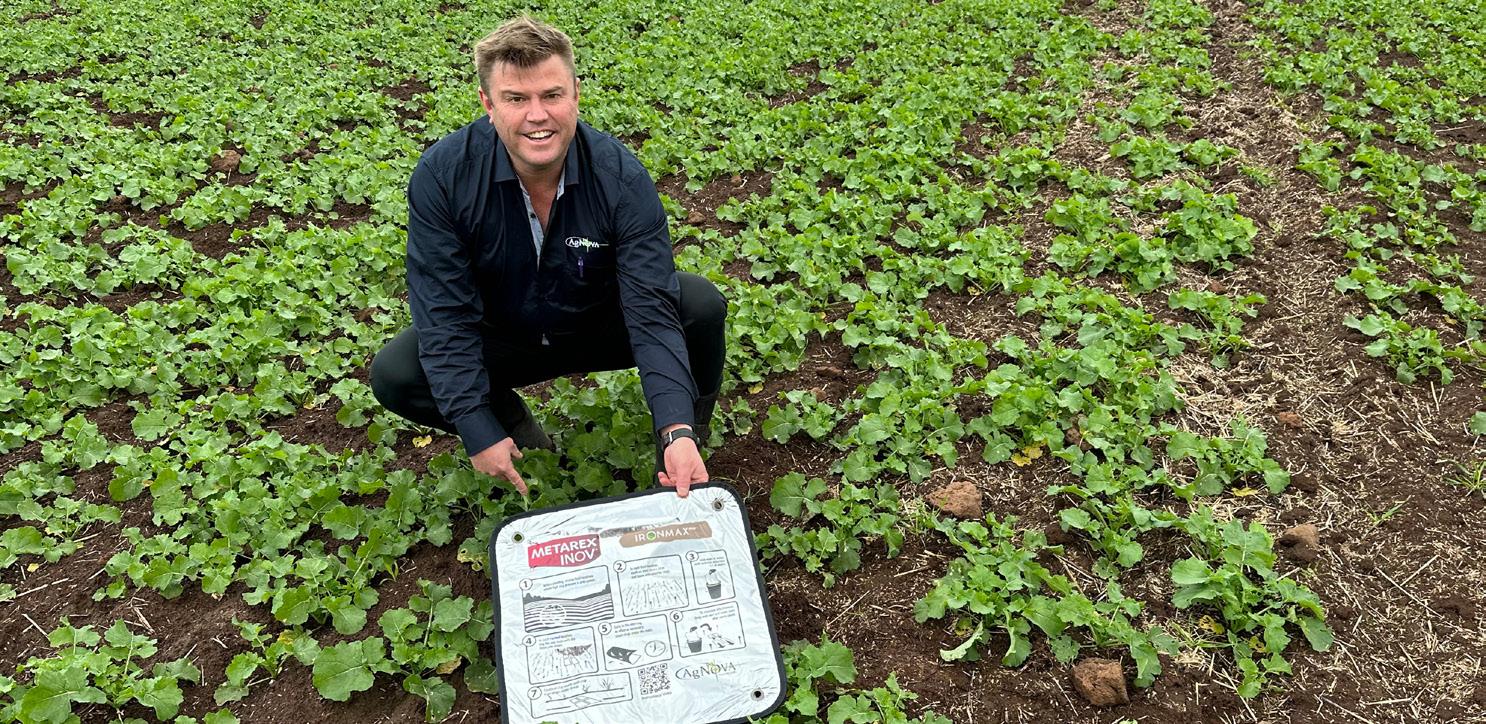
These 2024 observations contrast to those following the wet spring in 2022 that favoured slug breeding, with black keeled slugs still laying eggs in late November, leading to extremely high slug populations at crop establishment in 2023. From this long-term monitoring, it can be concluded that long cool springs favour slug recruitment and reduce juvenile slug mortality. Slug activity, when crops are emerging, requires a soil water potential to be somewhere towards field capacity, that is, for a clay loam soil type, volumetric soil moisture greater than 25 to 30 per cent (pc). Temperature is an important factor determining slug activity, that is, slugs are less active when the soil temperature is less than 10 to 12°C. GRDC is supporting the development of models to validate the conclusions presented here and help inform slug risk decision support tools in the future.
In 2024, proactive growers who applied bait after seeding to protect seed and seedlings had no crop losses, even in areas where summer rainfall or irrigation saw slugs active in January. This result could have been due to low populations being less active due to dry establishment conditions, in combination with some bait applied as insurance. Given the dry spring in 2024 and low soil moisture, it is expected that low slug populations will persist into 2025. Furthermore, following two dry springs, the potential for large numbers of black keeled slugs to persist into 2025 is low.
However, slugs observed on the soil surface are only the active proportion of the slug population; the total number is often much greater. This highlights the need to not be complacent and, if soils are at field capacity (35 to 45 pc moisture) when the crop is establishing, a greater proportion of slugs will be at the surface, feeding on seedlings.
For those areas that traditionally experience slugs, despite the expectation of lower numbers of slugs in 2025, if conditions are wet at seeding and establishment of canola is slow, baiting after sowing but before crop emergence is recommended. Use longlasting baits, such as Metarex Inov, for sustained control where monitoring of establishing crops every 3 to 4 days is not possible.
For those areas that are new to slugs, ongoing research is seeking to determine the years where bait needs to be applied, so no recommendations can be made on baiting at present. The question is: can you afford to take the risk of having to resow crops in cold wet conditions?
Real-time monitoring of snails using cameras deployed at Warooka SA indicates juvenile snails are active on dews, trying to rehydrate, but are not showing interest in baits. Conical snails are not taking baits either. The current message has been to roll paddocks to reduce snail numbers in February/ March prior to baiting once snails are hydrated and actively feeding, but before egg laying occurs.
Timing of controls is critical for success. In 2025, this may mean baiting once heavy dews and cooler temperatures occur; when round snails are actively feeding in March; and again, later in April, when conical snails are actively feeding. However, in 2024, there were few opportunities to bait conical snails due to the late break. Growers need to monitor the state snails are at and apply bait accordingly, highlighting the importance of the development of realtime monitoring tools.
Suction filter washed with water.
Suction filter cleaned with All Clear DS.

When it comes to removing damaging residues from your boom sprayer, All Clear DS outperforms other tank cleaners on the widest range of products.
Feature Benefit
Single dilution rate Convenient and simple to use
Non-corrosive No equipment damage
Low foam
Long shelf life

Easy to empty spray tank
Carry over season to season + +
To physically remove residues and stop re-sticking
To solubilise and break down residues
To lock up molecules and improve rinse out

Trace minerals are required for optimal growth, reproduction, and immunity. Optimising trace mineral status relying solely on oral supplements across a herd may fail because of variation in individual intake and reduced absorption due to antagonism of other ration components and minerals.
Any aspect of trace mineral status impairment can have significant implications on the cow. There is only a short window of two to three months where the cow has a chance of becoming pregnant in time to remain in sync with our production systems and produce a calf every year.
The use of injectable trace mineral supplements has been associated with positive reproductive outcomes including improved conception rate, increased odds of pregnancy and greater final in calf rate.
A study conducted on 2,168 dairy cows, administered injectable trace minerals, four weeks prior to calving and again four weeks prior to the start of mating showed treated animals had a 3.3 per cent (pc) greater final in-calf rate, and a reduced time from start of mating to conception, compared to control animals1.
Another study has shown that cows treated with injectable trace minerals were associated with a significant reduction in both clinical and subclinical mastitis, highlighting the benefits that trace element supplements can have on pasture-based dairy cows2
Dr Carl Eden, Technical Services Veterinarian with Boehringer Ingelheim said “Vitamin B12 is sometimes referred to as a ‘super vitamin’ because it is only required in very small amounts but vital to many essential metabolic pathways. However, demand for B12 can vary considerably during the year and we see serum levels of B12 fall at critical times, such as the first few months after calving.”

Vitamin B12 contains cobalt, so deficiency in cobalt can lead to deficiency in vitamin B12 because ruminants get most of their B12 as a byproduct of ruminal fermentation where the bacteria in their rumen assemble B12 from cobalt for use by the cow.
Sub-optimal trace mineral and vitamin B12 status at calving, mating, and drying off has been shown to negatively impact growth, reproduction, and immunity.
Using a trace mineral injectable containing vitamin B12 can improve trace mineral and vitamin B12 status at these critical times.
In the largest trace element study to date, Marks-Min Injectable Trace Mineral with Vitamin B12 demonstrated remarkable results when compared to a reference trace mineral injection.
“Given the differences between MarksMin and other products on the market, we wanted to generate a compelling data set to demonstrate how effective it was compared to the pioneer product. We entrusted this work to a third-party research company,” said Dr Eden.
“We chose farms that were at the top of their game from a reproductive perspective. We made sure that the farms had no evidence of trace element or Vitamin B12 deficiencies or excess.” Across all outcomes of interest, MarksMin demonstrated clear non-inferiority when compared to the reference product. Outcomes measured included submission, pregnancy and conception rates, and six week in-calf rate. MarksMin demonstrated it is highly suited as an alternative treatment to the reference product.
Dr Eden commented “we all love data, and this is a great data set as it opens options. Marks-Min joins the ranks of proven injectable trace mineral preparations and gives advisors and farmers an alternative to Multimin with the added benefit of B12 to support optimal health fertility and production.”